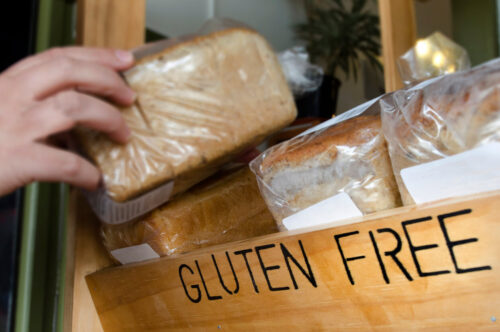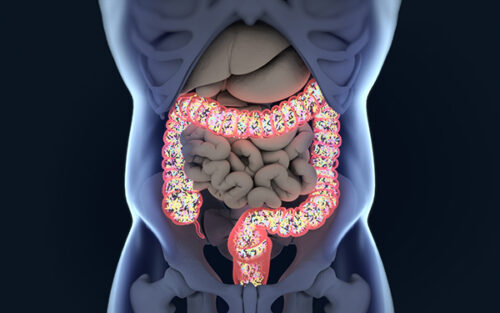How Do I Gain Weight on the McDougall Diet? I’m Not Joking!
By John McDougall, MD
(Please do the opposite of the advice below to lose weight faster)
One common question I get from people who seriously follow my instructions is, “How do I stop losing weight?” For example, this e-mail from a woman says, “I was a 100% raw foodist for almost 2 years and this past 10 days I came off that diet and went on your plan. My question is this: your plan is definitely the ONE; however, I was only 105 pounds as a raw foodist (usually high in fat with nuts, seeds, avocados, etc. and sugars from fruits and juices) and since eating your cooked low-fat plan, I am losing weight and only weigh 100 pounds now. How do I increase my body weight?”
Maybe the Problem is One of Perception?
You and your friends are used to looking at you at one size and now the change is difficult to adjust to and uncomfortable for many. Fortunately, people when they first meet folks who follow a healthy diet will likely think how exceptional they look – they are not burdened by past perceptions. There is also the problem of envy from those who wish they could lose weight so easily and were as thin. They may say, “You look so thin. Have you been ill?”
A participant in one of our recent live-in programs in Santa Rosa asked me, “Don’t you think Mary (McDougall) is a little too thin?” My reply was, “Have you noticed our dietitian, Jill, our psychologist, Doug, and our administrator, Heather (McDougall)?” “Yes, they’re thin, too,” she replied. My response was clear, “Our staff members are trim, vigorous, and young looking for a simple reason; they follow the McDougall diet and exercise program. You should be so lucky.” (By the way, no one ever accuses me of being too thin – possibly because I have no hesitation in eating large amounts of food and strenuously exercising while windsurfing on the water off Northern California.)
The Kempner Rice Diet Program Knows about Trim Weight
I have used a chart from the Kempner Foundation for more than 20 years to help people who think they are becoming too thin to realize that their new weight may actually be an ideal weight when it comes to good health. Walter Kempner, MD, established the Rice Diet Program in the 1940s at Duke University and until very recently this program was an important part of Duke’s medical department. The Rice Diet begins with mostly rice and fruit and then expands to other foods as people become healthier and thinner.
Again, the purpose of showing these figures is to help reassure you that you are not becoming too thin on the McDougall Diet – you should not look at these as goal weights.
This chart records what Kempner considered to be reasonable adult weight in proportion to height. He also recommended that people with diabetes, heart, kidney, or blood vessel diseases should weigh l0-l5% less than the optimum figures presented in this chart.
| Women | |
| Height | Weight Should be below* pounds |
| 4 ft 11 in | 91 |
| 5 ft | 94 |
| 5 ft 1 in | 97 |
| 5 ft 2 in | 100 |
| 5 ft 3 in | 104 |
| 5 ft 4 in | 108 |
| 5 ft 5 in | 112 |
| 5 ft 6 in | 117 |
| 5 ft 7 in | 122 |
| 5 ft 8 in | 127 |
| 5 ft 9 in | 132 |
| 5 ft 10 in | 137 |
| 5 ft 11 in | 142 |
| 6 ft | 147 |
| * Fully Dressed |
| Men | |
| Height | Weight Should be below* pounds |
| 5ft 2 in | 110 |
| 5 ft 3 in | 115 |
| 5 ft 4 in | 120 |
| 5 ft 5 in | 125 |
| 5 ft 6 in | 130 |
| 5 ft 7 in | 135 |
| 5 ft 8 in | 140 |
| 5 ft 9 in | 145 |
| 5 ft 10 in | 150 |
| 5 ft 11 in | 155 |
| 6 ft | 160 |
| 6 ft 1 in | 165 |
| 6 ft 2 in | 170 |
| 6 ft 3 in | 175 |
| 6 ft 4 in | 180 |
| 6 ft 5 in | 185 |
| * Fully Dressed |
Even though you will not look at these figures as your goal weight, if you follow a starch centered meal plan, as I recommend, and exercise, you could easily end up at a weight close to Dr. Kempner’s figures. So be reassured you are not too thin.
How Do You Tell If You’re the Right Weight?
Take off all of your clothes and stand in front of the mirror. Do you like what you see? All the weight charts in the world pale in importance to your own perceptions.
One Important Precaution. If you are too thin and have any concern that this might be a health issue then please check with your doctor. Illnesses, like cancer, infectious diseases (AIDS), liver and thyroid disease can also cause excessive weight loss. So can some serious psychological problems, like anorexia and depression.
How to Gain Weight in a Healthful Manner
I have known people who stop eating our diet with the excuse that they became too thin. This was almost always just an excuse to go back to burgers and fries – an excuse like inconvenience, difficulty, pressure from a spouse, longing for cake and cookies, etc. – to stop my recommendations. Never use too much weight loss as a reason to stop a healthy diet and exercise program.
Many times people become “too thin” on our diet because they don’t like the food – and that is simply because they don’t take the time to make interesting dishes. A plain baked potato and three stalks of broccoli will not make a successful long-term diet for many people. If you want this for a lifestyle then you must take the effort to find 4 to 8 dishes that you like to eat and are willing to find the time to prepare. For example, oatmeal for breakfast, a soup and bread for lunch, and bean burritos or spaghetti for dinner.
Another common mistake is to think that our food plan is a diet of green and yellow vegetables. These foods – like broccoli, cauliflower, pea pods, and sprouts – are too low in calories to get you through the day. You would have to eat bushel baskets full to get your 2000 to 3000 calories. Our diet is centered on delicious higher calorie vegetable foods commonly referred to as starches – foods like rice, corn, potatoes, beans, pastas, and breads, are also called “comfort foods” because of the way they make us feel. To this higher calorie centerpiece are added green and yellow vegetable dishes and fruits. When I say “higher calorie” this is relative to the low calorie concentration found in green and yellow vegetables. (Higher calorie does not mean these choices will make you fat – becoming fat would be very difficult to accomplish on a starch-based diet – consider there are billions of people, like rural Chinese, who live on a starch-based diet (rice) and no one is fat – until they change to the Western diet. There are a few people running around swearing they follow the McDougall Diet and they look to be 50 to a hundred pounds overweight. The truth is they are following their interpretation of my recommendations – you can learn about unhealthy, overweight vegans – people eating no animal products – in my October 2002 Newsletter).
Gaining weight is usually a matter of more calories in than calories out of your body. Fats are the most easily stored of all three kinds of calories (protein, carbohydrates and fats). Any change in diet that raises insulin levels will make weight gain easier – insulin is the hormone that pushes fat into fat cells and prevents the release of fat.
Make the Following Changes in this Order to Regain Weight in a Healthful Manner
1) Eat more whole grain flour products like breads and bagels. Flour is more fattening than the whole grain because the change in physical properties that comes with milling causes faster and more complete absorption of the calories and a great rise in insulin response.
2) Eat more simple sugars in the form of fruits, dried fruits and fruit juices. This will cause a greater rise in insulin in your body.
3) Eat more high-fat plant foods, like nuts (and nut butters), seeds (and seed spreads), avocados, and olives. Fats are concentrated calories.
4) Add high-fat soy milks and tofu products. These are higher in fats.
5) Eat more high-fat soy foods. However, in general, these fake foods (like burgers, hot dogs, lunch meats, and cheeses) should be kept to a minimum because they are not very nutritious.
6) Eat more food – this is often difficult because most people already eat to the full satisfaction of their appetite. Making more delicious meals and taking more time to eat may help accomplish this.
7) Eat a greater variety of foods – new kinds of foods stimulate interest, which increases food intake.
8) Add salt, sugar and favorite spices to the surface of your foods. If they taste better to you then you will eat more. Plus sugar adds calories (empty calories).
9) Use salad dressing, barbecue and steak sauces (made without oils and animal products) over your dishes to make them taste better so you eat more. Many sauces also contain simple sugars that provide calories and raise insulin levels.
10) Exercise less. We all know people who are exercise fanatics and they burn 3000 to 5000 extra calories a day – making it very difficult for them to eat enough food to fully replenish the expenditure. One simple way to gain more weight, and in some ways improve your overall health, may be to exercise more moderately.
I have never seen any otherwise healthy person “starve to death” when there were adequate amounts of nutritious foods available to them. Your hunger drive is there to guarantee your personal survival by making sure you consume sufficient calories and nutrients. It works just fine when the correct foods are present – unprocessed starches, vegetables and fruits. With the wrong foods – meats, dairy products and refined and packaged foods – all bets are off and you are struggling for survival in this artificial world. The McDougall Program is the easiest and surest method of achieving trim body weight, and much better than fighting your hunger drive and losing the “lifelong battle of the bulge” – it works because the qualities of food match the size of the stomach, the strengths of the hunger drive, and the needs of the body – how could it not be this way in a perfectly created world that works so well for all other matters?
Recommended Articles

Gluten-Free Diets Are Harmful for the General Population (Except for One Percent)

Our Top 10 Favorite Ways to Eat Potatoes






Join the Conversation!
Have a question, a helpful tip, or a story from your journey? Add it below - your voice matters.